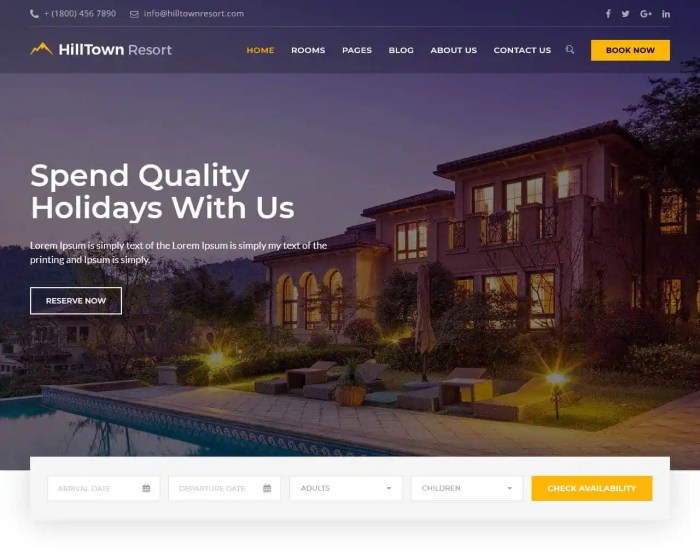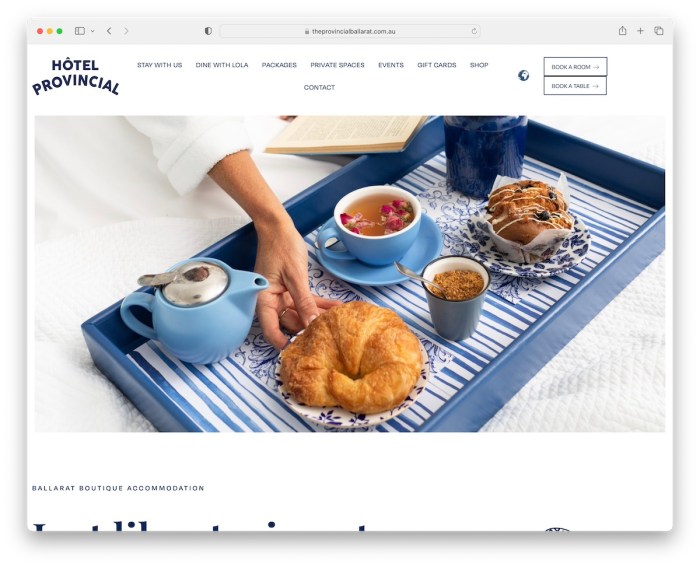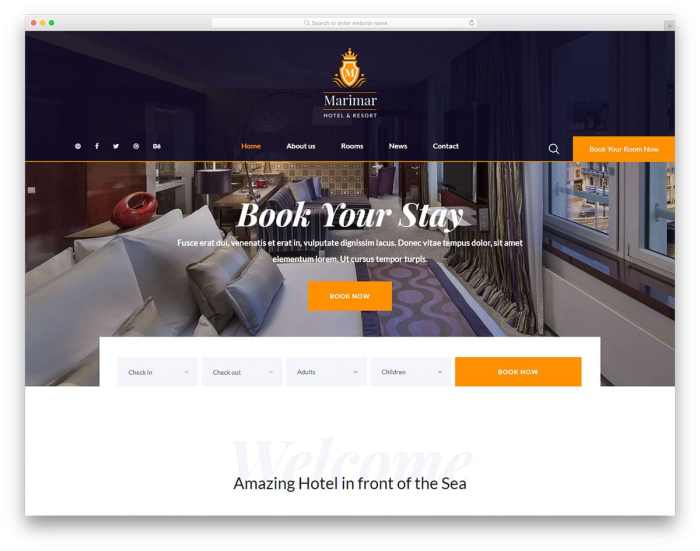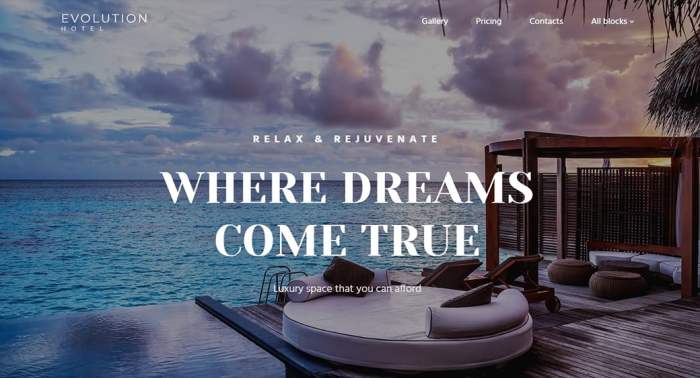Best Hotel Website Design & Functionality

Best hotel website design isn’t just about pretty pictures; it’s about seamlessly blending aesthetics with functionality to drive bookings. This guide dives into the key elements – from intuitive navigation and stunning visuals to a smooth booking process and effective marketing strategies – that make a hotel website truly exceptional. We’ll explore how to create a site that not only attracts visitors but also converts them into guests.
We’ll cover essential features like responsive design for optimal viewing across devices, accessible coding for inclusivity, and the strategic use of high-quality imagery and compelling copy to showcase your hotel’s unique selling points. Learn how to craft a user experience that’s both enjoyable and efficient, maximizing your online presence and ultimately boosting your bottom line.
Defining “Best” Hotel Website Features
Creating a truly exceptional hotel website requires more than just pretty pictures; it demands a strategic blend of aesthetics and functionality. A successful website needs to seamlessly guide users from initial browsing to final booking, all while maintaining a consistent brand identity. This involves understanding the key features that consistently elevate user experience and drive conversions.
Five key features consistently found on highly-rated hotel websites are high-quality photography, a streamlined booking process, clear and concise information, mobile responsiveness, and integrated customer reviews.
High-Quality Photography and Videography
High-quality visuals are paramount. Imagine a website showcasing stunning panoramic views of the hotel’s location, luxurious rooms bathed in natural light, and vibrant images of the hotel’s amenities, such as a sparkling pool or a sophisticated restaurant. These images should be professionally shot, high-resolution, and accurately represent the hotel’s offerings. Videos can further enhance this, offering virtual tours or showcasing the hotel’s ambiance and atmosphere. For instance, a luxury resort might feature a drone video showcasing its breathtaking beachfront location, while a boutique hotel in the city center might highlight its stylish rooms and nearby attractions through a series of short, engaging videos.
Streamlined Booking Process
The booking process should be intuitive and frictionless. A well-designed website will feature a prominent “Book Now” button, clear room options with pricing details, and a straightforward booking form. Consider the ease of use of sites like Expedia or Booking.com; these platforms prioritize a simple, step-by-step booking process that minimizes the number of clicks required to complete a reservation. The website should also clearly display all fees and taxes upfront, avoiding hidden charges that could frustrate potential guests.
Clear and Concise Information
Essential information, such as hotel policies (cancellation, pet policies, etc.), amenities, and location details, should be readily accessible. This information should be presented in a clear, concise, and easily scannable format, using bullet points, headings, and concise paragraphs. For example, a section clearly outlining check-in/check-out times, parking options, and accessibility features would be beneficial. A detailed FAQ section addressing common guest inquiries can further enhance user experience.
Mobile Responsiveness
Given the prevalence of mobile browsing, a responsive design is crucial. The website should adapt seamlessly to different screen sizes and devices (desktops, tablets, smartphones), ensuring a consistent user experience regardless of the device used. This means text and images should resize appropriately, and navigation should remain intuitive on smaller screens. Failure to optimize for mobile can lead to high bounce rates and lost bookings.
Integrated Customer Reviews
Displaying positive customer reviews builds trust and credibility. Integrate a system that showcases verified guest reviews from platforms like TripAdvisor or Google Reviews. These reviews should be prominently displayed on the website, ideally alongside photos and ratings. For example, a dedicated “Guest Reviews” section could display a star rating, a summary of reviews, and direct links to the review platforms. This transparency demonstrates the hotel’s commitment to guest satisfaction and encourages potential guests to book with confidence.
User Experience: Visual Appeal vs. Functionality
A visually appealing website is important, but it’s only one piece of the puzzle. While stunning visuals can attract initial attention, a website with superior functionality—a seamless booking process, easy navigation, and readily available information—will ultimately lead to higher conversion rates. The ideal website strikes a balance between aesthetic appeal and practical usability. A visually stunning website with poor functionality will frustrate users and deter bookings, while a functional but visually unappealing website might lack the initial appeal needed to attract visitors. The best websites prioritize both, creating a user experience that is both enjoyable and efficient.
Homepage Design Prioritizing Ease of Booking
A homepage designed to prioritize ease of booking should feature a prominent “Book Now” button above the fold, ideally within the first few seconds of scrolling. High-quality images showcasing the hotel’s key features (rooms, amenities, location) should be strategically placed to visually attract users. A concise description of the hotel’s unique selling points should be present, along with key information like location and pricing. Below the fold, sections detailing amenities, guest reviews, and a simplified booking calendar could be included. The overall layout should be clean, uncluttered, and easy to navigate, with clear calls to action guiding users toward the booking process. The design should be consistent with the hotel’s brand identity, creating a cohesive and professional impression.
Website Navigation and User Experience (UX)

Source: templatemag.com
A seamless and intuitive website experience is crucial for converting website visitors into paying guests. Clear navigation, fast loading times, and a mobile-friendly design are all key components of a successful hotel website. Poor UX can lead to frustrated users abandoning their booking attempts, resulting in lost revenue. This section explores how to optimize your hotel website for a positive user experience.
User Flow Diagram for Room Booking
A well-designed user flow guides customers effortlessly through the booking process. Below are two example scenarios, illustrating the paths a customer might take to book a room. These diagrams highlight the importance of clear calls to action and intuitive page layouts.
Scenario 1: Direct Booking
Imagine a customer arriving at the homepage. They navigate to the “Rooms” section, select their preferred room type and dates, review their booking details, and finally proceed to checkout. This straightforward path emphasizes ease of navigation.
Scenario 2: Package Deal Booking
Here, a customer might begin on the homepage and see a prominent “Packages” section. They choose a package, select their dates, and proceed to checkout. This path highlights special offers and adds value for the customer. Both scenarios ideally lead to a clear, concise checkout process.
Responsive Design Impact on Hotel Website Performance
Responsive design ensures your website adapts seamlessly to different screen sizes (desktops, tablets, smartphones). This is paramount for a positive user experience across all devices. A non-responsive site, on the other hand, can be frustrating and difficult to navigate on smaller screens, leading to high bounce rates.
Example of Good Responsive Design: A hotel website that automatically adjusts the layout and image sizes to fit the screen, ensuring all content is easily accessible and readable regardless of the device. Navigation menus might collapse into a hamburger menu on smaller screens for space efficiency.
Example of Bad Responsive Design: A hotel website that remains fixed in its desktop layout on mobile devices, requiring excessive scrolling and pinching to view content. Images might be too large, and text might be too small to read comfortably. Navigation could be hidden or difficult to access.
Website Accessibility Best Practices
Website accessibility ensures usability for people with disabilities, including visual, auditory, motor, and cognitive impairments. Following accessibility guidelines improves your website’s inclusivity and reach.
Implementing accessibility involves several key practices. Providing alternative text for images using the `alt` attribute is crucial for visually impaired users who rely on screen readers. Using proper heading structure helps screen readers and users navigate the page’s content logically. Clear and concise language avoids confusion, and sufficient color contrast between text and background ensures readability. The WCAG (Web Content Accessibility Guidelines) provides detailed recommendations for web accessibility. Furthermore, keyboard navigation should be intuitive and allow users to complete all tasks without a mouse.
Visual Presentation and Branding: Best Hotel Website

Source: colorlib.com
A luxury hotel website needs to visually communicate opulence, sophistication, and a memorable guest experience. This is achieved through a carefully curated color palette, typography, and the strategic use of high-quality visuals. Every element should contribute to a cohesive and luxurious brand identity.
The visual presentation is crucial in setting the right tone and attracting the target audience. A poorly designed website can damage the hotel’s reputation before a guest even steps foot inside.
Ideal Color Palette and Typography for a Luxury Hotel Website
The color palette should evoke feelings of serenity, elegance, and exclusivity. Think muted jewel tones like deep blues, rich greens, or sophisticated grays, accented with gold or a warm metallic tone to add a touch of luxury. Avoid overly bright or jarring colors. The color scheme should be consistent throughout the website to maintain brand unity. The typography should reflect the hotel’s style. A classic serif font for headings, paired with a clean sans-serif font for body text, creates a balance of elegance and readability. Font sizes should be appropriately sized for optimal legibility on various devices. For example, the Ritz-Carlton often uses a sophisticated serif font for headings and a clean sans-serif for body text to project a sense of understated luxury.
High-Quality Photography and Videography for Showcasing Hotel Amenities and Atmosphere
High-resolution images and videos are essential for showcasing the hotel’s amenities and ambiance. Photography should be professionally shot, well-lit, and capture the essence of the hotel’s unique selling points. Think of stunning shots of the lobby, rooms, restaurants, spa, and surrounding scenery. Videos can showcase hotel experiences like a virtual tour, showcasing the amenities, or capturing the lively atmosphere of the hotel’s bars and restaurants. For optimal online display, images should be at least 2000 pixels on their longest side, saved as JPEGs for photography and PNGs for graphics with transparency. Videos should be encoded in MP4 format with a resolution of at least 1080p (Full HD) for a high-quality viewing experience. For example, the Four Seasons often uses high-quality, professionally shot videos and images to showcase their luxurious hotels and amenities, including stunning landscapes and exquisite interiors.
Hotel Website Banner Design: Special Offer
This mock-up showcases a special offer banner for a luxury hotel.
| Element | Description |
|---|---|
| Image | A high-resolution (at least 2000px wide) image showcasing a luxurious hotel room with a stunning view. The image should be bright, sharp, and professionally shot, emphasizing the comfort and elegance of the room. The file type would be a JPEG. |
| Headline Text | “Escape to Paradise: 20% Off Your Next Getaway” (Large, bold, elegant serif font) |
| Sub-headline Text | “Book your dream vacation now and enjoy luxurious amenities and unforgettable experiences.” (Smaller, clean sans-serif font) |
| Call to Action Button | “Book Now” (Prominent button with a clear call to action, potentially using a contrasting color to the overall banner design) |
| Background Color | A soft, muted color that complements the image and text, perhaps a subtle shade of blue or gray. |
Booking Process and Functionality
A smooth and efficient booking process is crucial for a successful hotel website. A complicated or frustrating booking experience can lead to lost bookings and negative reviews. This section examines the booking process on three different hotel websites, identifies areas for improvement, and details how to create a seamless online booking experience, including mobile optimization and booking engine integration.
Let’s analyze the booking processes of three hypothetical hotels – “Luxury Inn,” “BudgetStay,” and “EcoResort.” Luxury Inn boasts a visually stunning website but a cumbersome booking process. BudgetStay prioritizes speed but sacrifices user experience clarity. EcoResort, while aesthetically pleasing, lacks mobile optimization. These examples highlight common issues and opportunities for improvement.
Comparison of Booking Processes on Three Hotel Websites
The following table compares the booking processes of Luxury Inn, BudgetStay, and EcoResort, highlighting their strengths and weaknesses.
| Hotel | Strengths | Weaknesses | Areas for Improvement |
|---|---|---|---|
| Luxury Inn | Visually appealing website, detailed room descriptions | Multiple page redirects during booking, lack of clear progress indicators, no guest account option | Streamline the booking process into fewer steps, implement a clear progress bar, and add a guest account feature for faster repeat bookings. |
| BudgetStay | Fast loading times, minimal steps in the booking process | Lack of visual appeal, limited room information, no option for special requests | Improve the visual design and add high-quality images, provide more detailed room information, and add a section for special requests (e.g., early check-in, cribs). |
| EcoResort | Eco-friendly theme, clear pricing | Poor mobile responsiveness, slow loading times on mobile, lack of interactive map | Optimize the website for mobile devices, improve image optimization for faster loading, and incorporate an interactive map showing room locations and hotel amenities. |
Creating a Seamless Online Booking Experience
A seamless online booking experience should be intuitive, user-friendly, and optimized for all devices. Key elements include clear navigation, concise forms, secure payment gateways, and confirmation emails.
- Clear and Concise Information: Provide clear and concise information about room types, amenities, pricing, and policies. Use high-quality images and videos to showcase the hotel.
- Simple and Intuitive Navigation: Make it easy for users to find the information they need. Use clear and consistent labeling and a logical site structure.
- Easy-to-Use Booking Form: Keep the booking form short and simple. Only ask for essential information. Use clear labels and input fields. Consider using autofill functionalities.
- Secure Payment Gateway: Use a secure payment gateway to process payments securely. Display security badges and trust seals to build user confidence.
- Instant Booking Confirmation: Provide instant booking confirmation via email and/or SMS. Include all essential booking details in the confirmation.
- Mobile Optimization: Ensure the website is responsive and works seamlessly on all devices, including smartphones and tablets. Optimize images and loading speeds for mobile.
Integrating a Booking Engine with a Hotel Website, Best hotel website
Integrating a booking engine requires technical expertise. Choosing the right booking engine and understanding the technical requirements are crucial for a successful integration.
- Choosing a Booking Engine: Select a booking engine that meets your hotel’s needs and integrates seamlessly with your website. Consider factors such as pricing, features, and customer support.
- API Integration: Most booking engines use APIs (Application Programming Interfaces) to connect with websites. This requires working with developers familiar with API integration and your website’s programming language (e.g., PHP, Python, JavaScript).
- Website Modifications: You may need to make modifications to your website’s code to accommodate the booking engine’s integration. This could involve creating new pages, adjusting existing layouts, and ensuring compatibility with the booking engine’s design.
- Testing and Debugging: Thoroughly test the integrated booking engine to ensure it functions correctly on all devices and browsers. Address any bugs or errors before launching the website.
- Security Considerations: Implement robust security measures to protect sensitive user data. This includes secure payment gateways, data encryption, and regular security audits.
Content and Marketing Strategies

Source: uicookies.com
Crafting compelling website content and implementing effective marketing strategies are crucial for attracting guests and driving bookings. A well-executed strategy leverages your hotel’s unique selling points, builds trust through social proof, and guides visitors toward making a reservation. This involves more than just listing amenities; it’s about creating an engaging narrative that resonates with your target audience.
Compelling Website Copy Examples
Effective website copy goes beyond simply stating facts; it paints a picture and evokes emotion. Instead of saying “We have a pool,” try something like “Dive into relaxation at our sparkling infinity pool, overlooking breathtaking ocean views, perfect for unwinding after a day of exploring.” This approach creates a more vivid and appealing image in the reader’s mind. Another example: instead of “Comfortable rooms,” consider “Sink into plush bedding in our spacious rooms, designed for ultimate comfort and tranquility. Each room boasts stunning views and thoughtful amenities to ensure a memorable stay.” Highlighting unique features, such as locally sourced artwork or sustainable practices, can further differentiate your hotel. For example, “Experience the local artistry within our hotel, featuring original works by renowned regional artists, reflecting the vibrant culture of our city.” Finally, focus on the experience, not just the features. “Escape the every day and discover tranquility in our luxurious spa, offering a range of rejuvenating treatments designed to restore your mind, body, and soul.”
The Role of Customer Reviews and Testimonials
Customer reviews and testimonials serve as powerful social proof, significantly influencing potential guests’ booking decisions. Positive reviews build trust and credibility, showcasing the genuine experiences of past guests. To effectively display these elements, prioritize reviews from reputable sources, and ensure they are prominently featured on your website. Consider using a dedicated section on your homepage or individual room pages. Visually appealing displays, such as star ratings and short excerpts, can capture attention. Consider using a carousel to showcase a rotating selection of reviews, ensuring variety and preventing the page from becoming overwhelming. For example, a carousel could show a review about the exceptional service, another about the beautiful rooms, and a third about the convenient location. Furthermore, highlight reviews that address specific concerns or objections potential guests might have, addressing potential hesitations before they arise. For example, if some reviews mention noise levels, showcase reviews that counter that by highlighting the hotel’s soundproofing measures or quiet atmosphere.
Effective Calls to Action (CTAs)
Calls to action (CTAs) are crucial for guiding visitors toward completing a desired action, in this case, making a reservation. Effective CTAs are clear, concise, and visually prominent. The psychology behind their design lies in creating a sense of urgency and making the next step easy. Instead of a generic “Book Now,” consider using more compelling phrases like “Reserve Your Paradise Today,” “Escape to Luxury: Book Your Getaway Now,” or “Your Dream Vacation Awaits: Book Now.” These options evoke a stronger emotional response and highlight the benefits of booking. Using strong action verbs and creating a sense of scarcity (e.g., “Limited-Time Offer”) can further enhance their effectiveness. The placement of CTAs is also important. They should be strategically located throughout the website, appearing prominently on the homepage, room pages, and other relevant sections. Using contrasting colors and visually appealing button designs will further draw attention to the CTAs, ensuring they don’t get lost in the website’s design. Finally, ensure that your CTAs are mobile-friendly, as a significant portion of bookings occur through mobile devices.
Ending Remarks

Source: motocms.com
Creating the best hotel website requires a holistic approach, blending art and science to deliver a superior user experience. By focusing on intuitive navigation, stunning visuals, a seamless booking process, and a compelling marketing strategy, you can transform your online presence into a powerful revenue-generating tool. Remember, the goal is not just to attract visitors but to convert them into loyal guests. Prioritize user needs, continuously analyze performance, and adapt your strategy to stay ahead of the curve.
Commonly Asked Questions
What’s the ideal length for a hotel website copy?
Keep it concise and scannable. Use short paragraphs and bullet points where appropriate. Focus on key information and avoid jargon.
How important is it for a hotel website?
Crucial! Properly ensure your site ranks highly in search results, driving organic traffic. Focus on relevant s related to your location, amenities, and target audience.
What are some good tools for managing hotel website bookings?
Many booking engines integrate directly with hotel websites. Research options like SiteMinder, Booking.com, and Expedia to find one that fits your needs and budget.
How often should I update my hotel website content?
Regularly! Update your website with fresh content, special offers, and blog posts to keep it engaging and relevant. Aim for at least monthly updates.
How can I track the performance of my hotel website?
Use analytics tools like Google Analytics to monitor key metrics such as website traffic, bounce rate, conversion rates, and time spent on site. This data will inform your future website improvements.
Comments are closed.